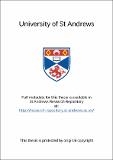Files in this item
The frequency stabilization of gas lasers
Item metadata
| dc.contributor.advisor | Maitland, Arthur | en |
| dc.contributor.author | Wallard, Andrew John | en |
| dc.coverage.spatial | 89 p | en |
| dc.date.accessioned | 2021-04-08T08:57:22Z | |
| dc.date.available | 2021-04-08T08:57:22Z | |
| dc.date.issued | 1972 | |
| dc.identifier.uri | https://hdl.handle.net/10023/21876 | |
| dc.description.abstract | This thesis contains a description of the design and development of a visible helium-neon laser stabilized to an absorption transition in an intracavity cell of iodine vapour. Two methods of frequency locking the laser have been studied, and a series of experiments has been performed in which the stability and reproducibility of the iodine stabilized laser have been investigated. Chapter 1 discusses the frequency perturbations which might be expected to appear on an unstabilized laser and the steps which may be taken to minimise such perturbations. Three methods of mode selection have been studied in some detail: short lasers, saturated neon absorption and intracavity etalons. These will also be discussed in Chapter 1. The Chapter closes with a discussion of the definition and measurement of frequency stability. The technological features of laser design are described in Chapter 2 together with some of the more important ancillary apparatus involved in these experiments. The Chapter concludes with a discussion of the servosystem techniques involved in frequency locking a laser. Chapter 3 discusses theoretical aspects of the work including the nature of saturated absorption, and the width of the expected saturated absorption peak to which the laser is stabilized; it concludes with an estimate of the laser powers required to achieve saturation. The operation of the laser is outlined in Chapter 4 which points out the advantages of the third derivative locking technique. A short discussion of laser noise problems is incorporated in this Chapter. Finally, Chapter 5 presents results obtained in experiments with two stabilized lasers and investigates the effects of saturated absorption linewidth broadening and shifts introduced by the detection system, the iodine pressure, and the laser power. Measurements of the long term stability have been made, and indicate that the laser frequency has a reproducibility better than 1 part in 10^10. The experiments discussed here indicate that a laser stabilized in this way possesses a stability and reproducibility superior to that of the existing length standard. These properties, together with the optical advantages of a laser source, could make this laser an eminently suitable successor to the existing Krypton lamp standard. | en |
| dc.language.iso | en | en |
| dc.publisher | University of St Andrews | en |
| dc.subject.lcc | TK7872.L3W2 | |
| dc.title | The frequency stabilization of gas lasers | en |
| dc.type | Thesis | en |
| dc.type.qualificationlevel | Doctoral | en |
| dc.type.qualificationname | PhD Doctor of Philosopy | en |
| dc.publisher.institution | The University of St Andrews | en |
This item appears in the following Collection(s)
Items in the St Andrews Research Repository are protected by copyright, with all rights reserved, unless otherwise indicated.

